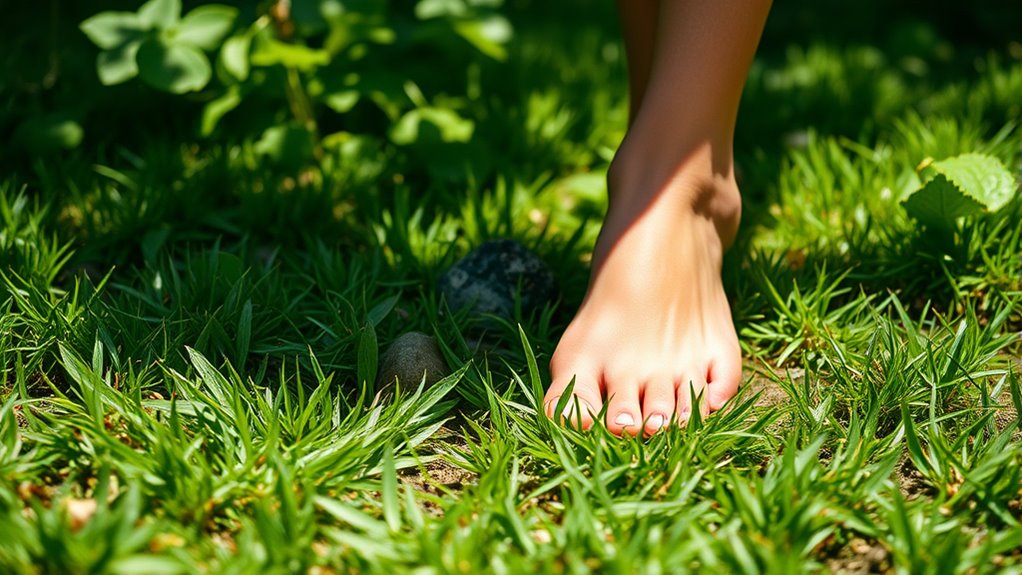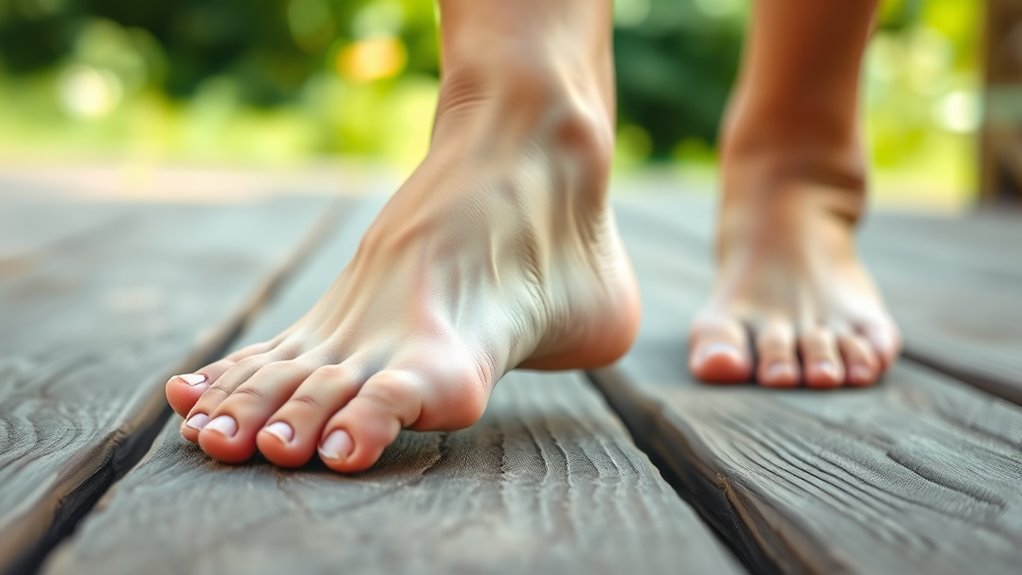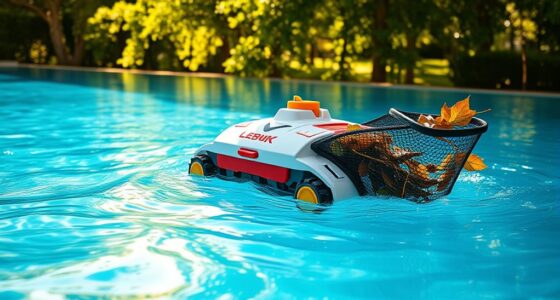To strengthen your feet safely through barefoot training, start with short sessions on soft surfaces like grass or sand, gradually increasing duration as your feet adapt. Focus on exercises like balance drills and toe strengthening to activate foot muscles and improve mechanics. Avoid sudden or prolonged barefoot activities, especially if you have pre-existing foot issues. Monitoring comfort and progressing gradually helps prevent injuries. Keep exploring further tips to enhance your barefoot journey effectively.
Key Takeaways
- Start barefoot training on soft, even surfaces like grass or sand to minimize injury risk.
- Gradually increase barefoot activity duration to allow foot muscles to adapt safely.
- Incorporate balance and toe-strengthening exercises to boost intrinsic foot strength effectively.
- Consult a healthcare professional before beginning if you have pre-existing foot conditions or health issues.
- Listen to your body and stop if you experience pain or discomfort during barefoot training sessions.

Have you ever wondered if taking off your shoes could improve your fitness? Barefoot training has gained popularity because it encourages you to connect directly with the ground, allowing your feet to move more naturally. When you ditch traditional footwear, you’re exploring footwear alternatives that promote better foot mechanics and strengthen muscles often neglected by cushioned shoes. This approach can lead to improved balance, agility, and proprioception. However, it’s essential to understand that barefoot training isn’t just about dropping your shoes—it’s about doing so safely to prevent injuries and maximize benefits.
One of the main reasons people turn to barefoot training is injury prevention. Modern shoes, especially those with thick soles and arch support, can sometimes weaken foot muscles over time. By training barefoot, you activate these muscles, helping to correct imbalances and develop the foot’s natural strength. This can reduce the risk of common injuries like plantar fasciitis, shin splints, and stress fractures. But, it’s vital to begin gradually. Transitioning too quickly can overload your muscles, tendons, and joints, leading to strains or bruises. Begin with short sessions on soft surfaces like grass or sand, and gradually increase duration as your feet adapt.
Another key point is understanding that barefoot training isn’t suitable for everyone right away. If you have pre-existing foot issues, diabetes, or compromised circulation, consult a healthcare professional before trying it. For those who are ready, incorporating barefoot exercises into your routine can be highly effective. For example, simple balance drills, toe strengthening exercises, or walking barefoot for brief periods can help your feet develop better intrinsic strength. Over time, this can translate into improved performance in other activities and reduce dependence on supportive footwear.
Frequently Asked Questions
Can Barefoot Training Improve Athletic Performance Long-Term?
You might wonder if barefoot training can boost your long-term athletic performance. It can, by increasing foot muscle activation, which enhances stability and power. Strengthening your feet also helps prevent injuries by improving support and resilience. Over time, these benefits translate into better performance and reduced setbacks. Just make certain you progress gradually and listen to your body to avoid overstressing muscles or joints.
How Do I Transition Safely to Barefoot Training?
Imagine walking barefoot through a gentle meadow—your feet need time to adapt. To shift safely, consider footwear considerations that support your feet initially, then move toward barefoot gradually. Start with short sessions, listen to your body’s signals, and increase intensity slowly. This gradual progression helps prevent injury and allows your feet to strengthen naturally. Patience and mindful steps ensure a smooth, safe shift to barefoot training.
Are There Specific Exercises for Strengthening Foot Arches?
To strengthen your foot arches, focus on arch strengthening through targeted foot exercises. Practice toe curls by gripping a towel with your toes, and try doming your arches by lifting the middle of your foot while keeping your heel and toes on the ground. These exercises improve arch support and overall foot strength, helping prevent injuries and enhance barefoot training benefits. Incorporate them regularly for noticeable improvements.
How Often Should I Incorporate Barefoot Training Into My Routine?
Imagine your feet as the roots of a mighty tree, needing care to stay strong. You should incorporate barefoot training 2-3 times a week, like tending to those roots. Using footwear alternatives on busy days protects your feet, while barefoot exercises aid injury prevention and build resilience. Balance is key—listen to your body, gradually increase frequency, and watch your foundation grow sturdier with each step.
What Are Common Mistakes to Avoid During Barefoot Exercises?
When doing barefoot exercises, avoid common mistakes like rushing or neglecting proper form. Don’t fall for footwear myths that suggest you need shoes for support, as barefoot benefits include improved strength and balance. Always listen to your body, start gradually, and focus on controlled movements. Skipping these steps can lead to injury, so prioritize technique over speed. Proper guidance helps you safely enjoy barefoot training’s full benefits.
Conclusion
As you embrace barefoot training, remember that strengthening your feet can unseal surprises you never expected. But beware—pushing too hard too soon might lead to setbacks you didn’t see coming. Stay mindful, listen to your body, and progress gradually. Are you ready to discover just how powerful your feet can become? The journey to stronger, healthier feet is just beginning—and what lies ahead could change the way you move forever.









